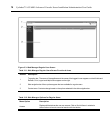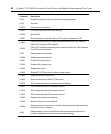
Appendix D: Accessing a Console Server with a DSView 3
Software Installation via Dial-up
When a DSView 3 software user establishes a serial session, the following events occur:
• The user selects a serial port to access.
• A viewer is downloaded from the DSView 3 server to the user's workstation.
• The DSView 3 software passes information to the viewer, such as an authorization key,
the console server's IP address and serial port.
• The viewer then accesses the console server's serial port through an SSH session by
passing the authorization key obtained from the DSView 3 server.
• The serial session begins.
To ensure constant connectivity, a DSView 3 server can be configured with an out of band
(OOB) “back door” that will allow it to call a console server via modem in the event of a
network or Internet failure.
Installing DSView 3 software with an OOB back door
The DSView 3 server must be running on hardware that has a connected modem, and the
console server must have a built-in modem or access to a modem via a PCMCIA card, USB or
serial port.
For this installation, the DSView 3 server must be the central point of reception of both the
packets leaving the downloaded viewer and the console server. To ensure this, Proxy mode
must be configured within the DSView 3 software. The viewer will then point to the DSView
3 server (not the console server) to establish the SSH connection. The DSView 3 server would
then route the packets by changing both the source and destination IP addresses and act as a
middle point of communication.
Under normal operating conditions, packets received from the Video Viewer would route
through the DSView 3 server via Ethernet. In an error state, the DSView 3 server would detect
that the normal path to the console server was interrupted and would dial out to the console
server, pass authentication and establish a PPP connection. Packets that would normally pass
via Ethernet would instead be routed via PPP.
Because of the speed differences between Ethernet and dial-up, performance would be notably
slower, but still present. Multiuser connections would further degrade performance and are not
recommended. For this reason, dial-up backup is recommended as an emergency backup feature
only.
Appendices 77


















